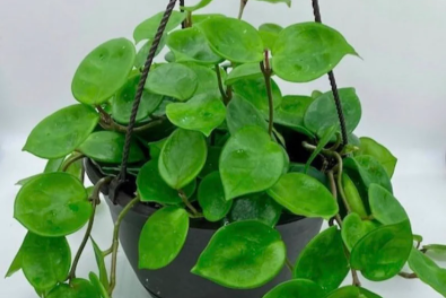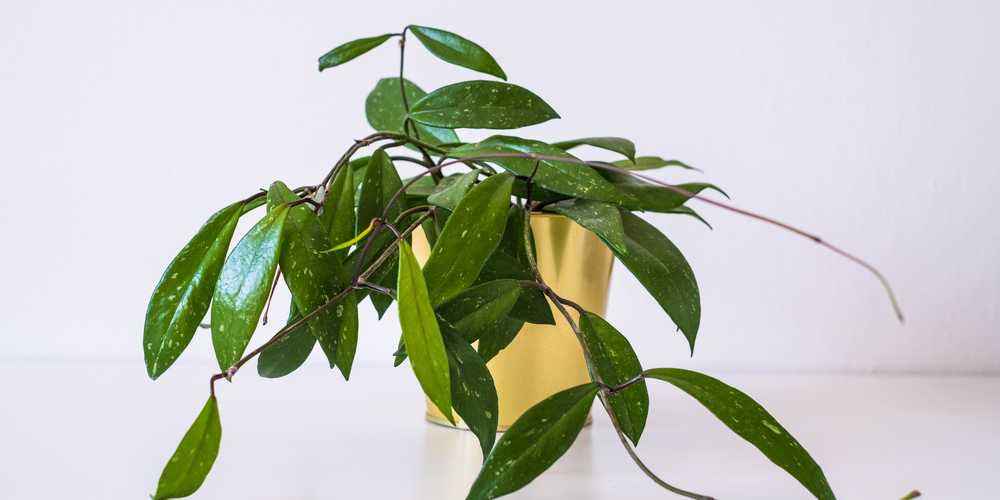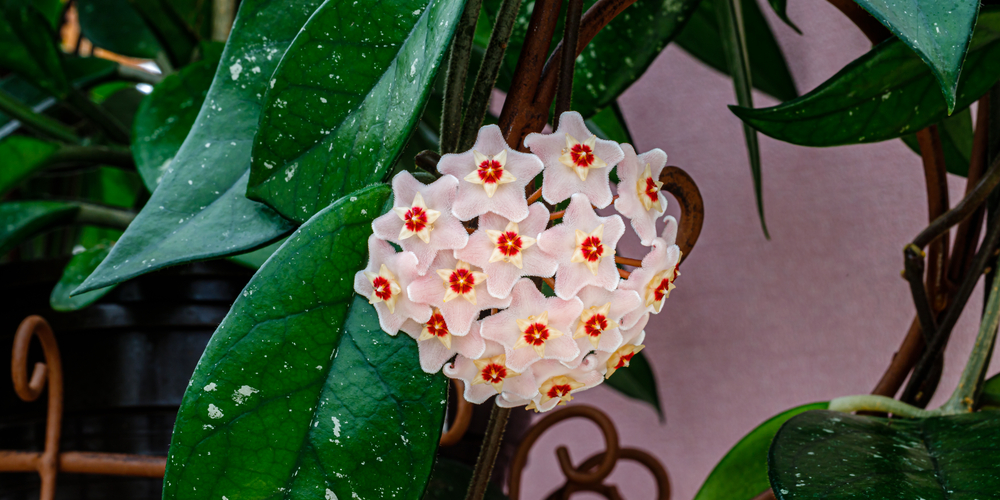Hoya Chelsea is a variety of Hoya Carnosa. For reference, Carnosa is one of the oldest varieties of Hoya, so this species has many cultivars. Most growers believe it is a cross between a Hoya carnosa and a Krinkle 8. But its origin cannot be confirmed.
This cultivar is a trailing plant. So, you can put it on a trellis or keep it in a pot for a bushier appearance. It grows fast. And unlike other selections, it is not finicky. On the contrary, it will thrive off of neglect, making it the ideal candidate for newer Hoya collectors.
This variety loves to grow outdoors in hot, humid environments (90-100 F). But you can also grow it indoors if you provide the right conditions. On top of that, a healthy specimen is also easy to propagate and does not require much fertilizer. The only tricky part is making it flower.
Hoya Carnosa Quick Facts

- Botanical Name: Hoya carnosa
- Common Names:L Hoya Chelsea, Porcelainflower, Wax plant
- Plant Type Perennial: (vine)
- Flower Color: White, Heavenly Pink, or Soft Pink
- Size When Mature: 6-15 inches (height), >6 inches (width)
- Bloom Time: Spring and summer
- Sun Requirements: Partial Shade/Bright indirect to filtered bright light
- USDA Hardiness Zones: 9b-11
- Soil PH Range: 4.5-7.2
- Soil Type: Moist, well-draining
- Water Needs: Low, only when mostly dry
- Native Area: Tropical Asia and Australia
What you Need to Know About Hoya Carnosa
Like any Hoyas, the Chelsea Wax plant needs light, well-draining soil. So, read the section below to give your Chelsea the best potting mix for rapid growth. Nothing beat of a full hanging basket of Chelsea. But without the correct soil and light requirements, you might need a little bit of extra patience with this one.
This cultivar is a pet-safe plant. But placing it outside the reach of your furry housemates is a good idea because accidental ingestion may cause stomach problems. Besides, its flowers exhale a delicate chocolatey scent, which may attract them even more.
The Chelsea will flower only if all the right conditions align. To be honest, it is not a likely scenario for first-timers. But with proper care, this plant blooms during spring and summer.
Some growers may think this cultivar is redundant if they have a Krinkle 8. So. let’s compare Hoya Chelsea VS Krinkle 8.
Hoya Chelsea VS Krinkle 8
Generally, the easiest way to tell the difference between a Chelsea and a Krinkle 8 is to look at the leaf shape. The Krinkle 8 has elongated leaves that tend to fold in half—you can think of them like small tacos. On the other hand, a Chelsea Wax plant has thicker, more rounded leaves that usually look like hearts when they have a point. Also, they do not fold but rest in a cupped form.
Most new leaves emerge with a light green color. Instead, the old leaves turn dark as they age. But sometimes, the new growth has a mesmerizing purplish-red hue that winds down all over the place, creating striking chromatic effects.
How to Care for Hoya Chelsea
Here’s everything you need to know about growing and caring for a thriving Hoya Chelsea
Light
Hoya Chelsea enjoys high light but no direct sun—Otherwise, the leaves will scorch. Filtered sunlight is ok too. But on the darker side of the pot, the growth will be less vigorous. So, be sure to rotate it every month for a fuller look.
The ideal place to keep this carnosa is in an east- or west-facing porch hanging basket. Of course, only if you live in a USDA zone ranging from 9b to 11. Indoors, you can keep it near a window. But depending on the humidity level, you might experience varying results. This is why many Hoya enthusiasts use a LED grow light for this Hoya, especially during winter. Or to promote flowering.
If your Chelsea never flowers, increase the hours and intensity of light.
Water and Soil Needs
Although you can buy pre-made soil mixes for Hoyas, making one may ensure better results. Every Hoya Chelsea has slightly different needs. So, making your soil mix will get you used to tweaking the formula and experimenting with new clones.
You can achieve a light, well-draining soil by mixing one-third part neutral, bagged soil with one-third part perlite and one-third part orchid bark. To explain, the orchid bark makes the soil mix slightly acidic (pH 4.5-7), which helps the roots absorb their nutrients.
No Hoyas want their shallow root system sitting in water or soggy, wet soil. Instead, their roots prefer to spread out and have enough space and moisture—but not too much—to keep moving. In nature, they would grow up the side of a tree where they might enjoy a drizzle every once in a while.
Underwatering your Hoya is better than overwatering it.
This plant does not fear drying out. And with a Chelsea in particular, you cannot be on a watering schedule after all. So, when you water it, make sure the water goes all the way through the soil mix.
Like most Hoya carnosa cultivars, this species is pretty good at telling you when it is thirsty. How can you see when an H. Chelsea needs water? When they are hydrated, the underside of the cupped leaves is smooth. But when the plant starts to get thirsty, the back of the leaves gets wrinkly and softer.
Temperature Requirements
All Hoya carnosa cannot stand cold temperatures—temperature should always be between 68-90 F. What’s more, Hoya Chelsea thrives in hot, humid environments and needs to be root-bound before producing flowers.
Excessive heat can stunt growth and cause damage, too. So, the ideal USDA zones are 9b-11. It can survive in harsher climates. But only indoors, as long as the humidity does not drop below 60%.
If the humidity level is lower than 60%, you had better water it carefully. But do not overwater it because that mistake will trigger root rot.
Fertilizer
The best fertilizer for a Hoya Chelsea is a 6-3-6 liquid fertilizer. But you can also dilute fish emulsion and apply the fertilizer every two or three months.
Common Diseases And Pests
Yellowing can happen for three major reasons:
- root rot
- sun stress
- underwatering
The typical Hoya Chelsea does not like to be too close to the grow light. So, the first step is to place your plants away from the light source. Likewise, wrinkliness coupled with yellowing can suggest the plant needs more water.
Generally, if you wait for the soil to dry out, you can avoid root rot. But if the situation does not improve, maybe the soil mix is too dense. So, you might have to take cuttings and change the medium or soil.
High humidity is often linked to a lack of airflow. But lack of airflow can cause bacterial infections. If you notice a bacterial spot, remove the infected leaf immediately.
Pest-wise, mealybugs flock to all Hoya carnosa plants like there is no tomorrow. What’s worse, they multiply quickly. So, if you see ANYTHING that remotely resembles cotton on your plant, take a closer inspection. Get rid of mealybugs as soon as possible, or your plant will not be able to recover!
Spider mites and thrips are also common pests. But mealybugs are the worst damaging ones, especially when the plant gets big.
Propagation
Water propagation works well for Hoya Chelsea cuttings. But here are a couple of extra steps to propagate your cuttings more satisfyingly.
- Take a hermetic plastic container and fill it with some Sphagnum moss.
- Pour some water until the peat moss is damp but not wet. For clarity, add a little bit of water and then smush it around. Repeat if the moss is still dry. Also, check the container from down below. Make sure no water is pooling at the bottom.
- Wash and stick a cutting inside the moss layer. Possibly, do not let the leaves touch the damp moss bed. Washing them with slightly warm water and a drop of hand soap before placing them in the container will remove any pests and clean the leaves.
- Close the container and open it briefly every two or three days to change the air.
To make a cutting, select stems with at least two nodes. Go for the older leaves since they already have new roots forming on the stem. In general, cutting the new peduncles is not recommendable.
How to Prune Hoya Chelsea
Pruning your Hoya Chelsea will create new growth. This variety needs you to trim it to achieve a bushy appearance—even if you do not need cuttings for making clones. Conversely, if you do not give your Chelsea a haircut, the plant will eventually stop growing.
All you need to prune your Porcelainflower is a pair of disinfected scissors.
Wait until spring to trim a bushy Chelsea. The best time to prune your growing plant is in early fall., Or right after flowering. Avoid damaging the newest peduncles, where the blooms were, or the plant will not be able to flower again next year.
Related Article: Hoya Krohniana Silver Care

